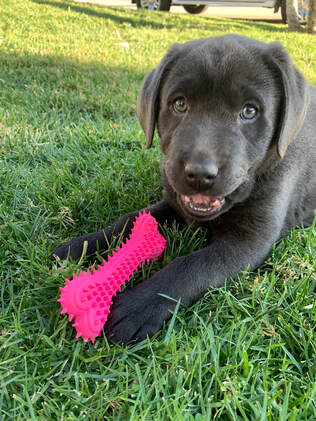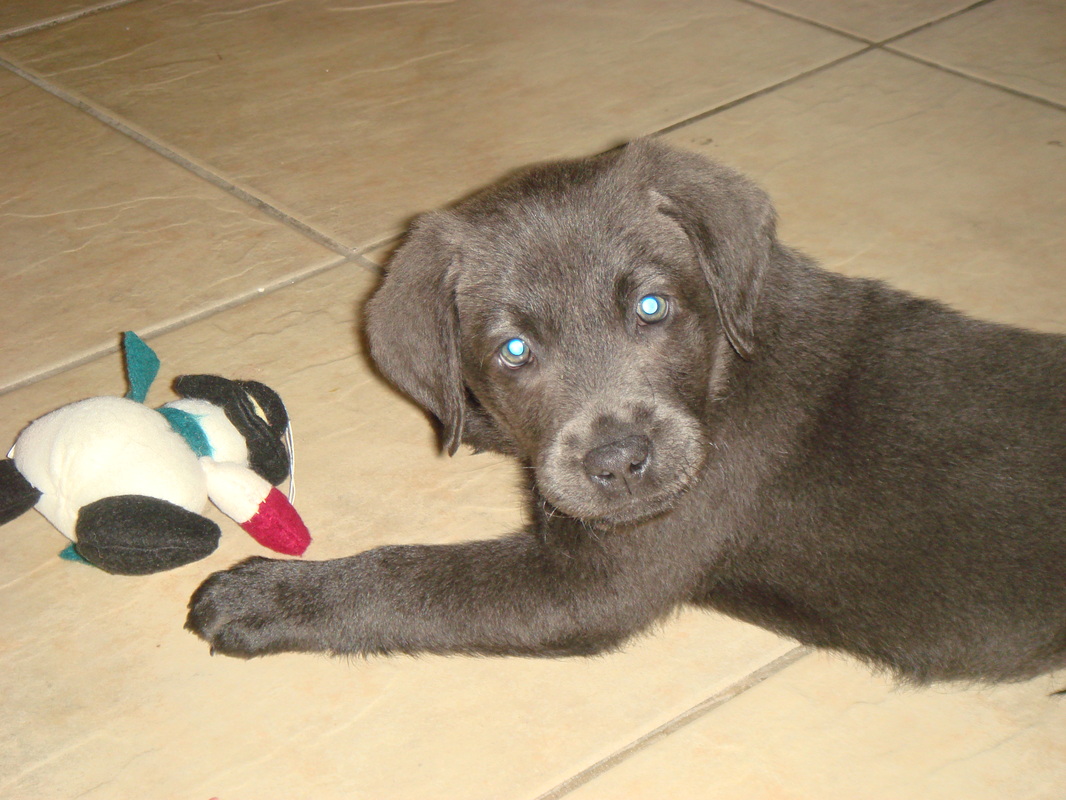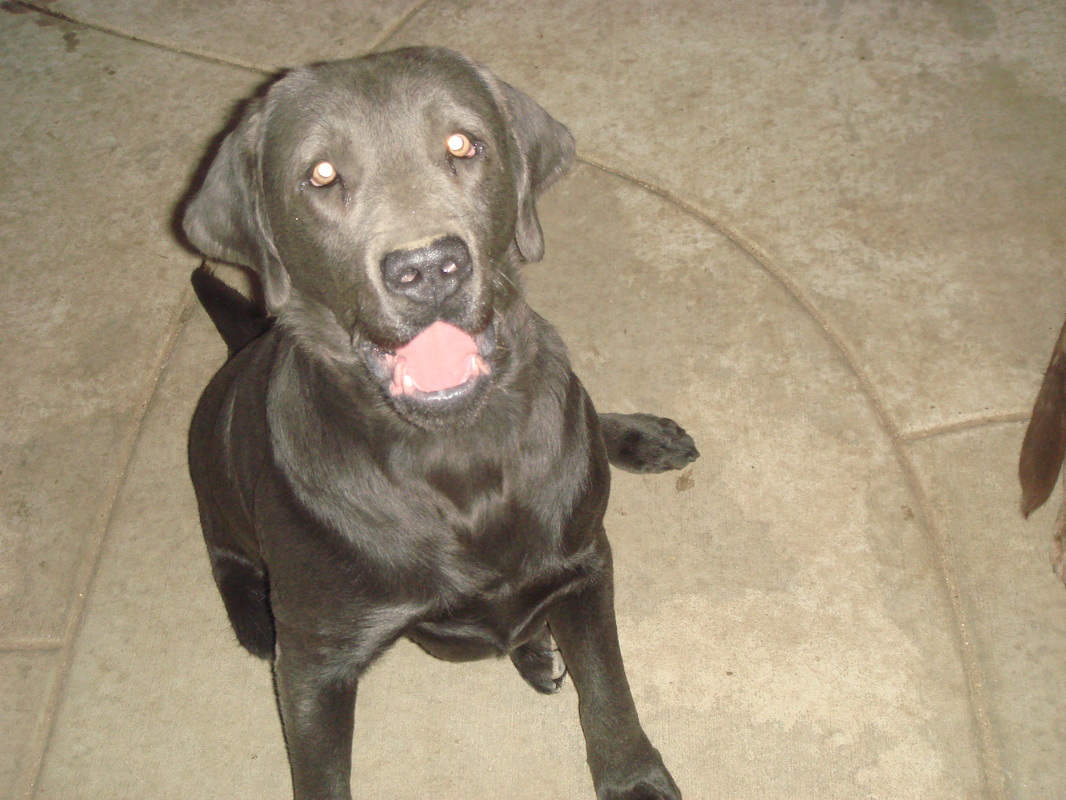Bailey
Charcoal
Our newest female Bailey is an outgoing fun-loving energetic girl. You will fall in love when you meet our charcoal sweetheart AKC Bailey!
Weight: 72 lbs.
Bailey is CLEAR of all of the following hereditary Disease that was tested. Centronuclear Myopathy (CNM), Cystinuria, Degenerative Myelopathy (DM), Exercise Induced Collapse (EIC), Hereditary Nasal Parakeratosis (HNPK), and Progressive Retinal Atrophy, Progressive Rod-Cone Degeneration (PRA-prcd)
Weight: 72 lbs.
Bailey is CLEAR of all of the following hereditary Disease that was tested. Centronuclear Myopathy (CNM), Cystinuria, Degenerative Myelopathy (DM), Exercise Induced Collapse (EIC), Hereditary Nasal Parakeratosis (HNPK), and Progressive Retinal Atrophy, Progressive Rod-Cone Degeneration (PRA-prcd)
Stassi
Charcoal
Let me introduce our favorite girl. Stassi is a very warm and friendly AKC Charcoal Silver lab. She has a distinct dilute black coat that gets attention everywhere she goes. People everywhere absolutely enjoy her unique charcoal color and friendly personality. Stassi has been vet certified and has routine checkups for optimal health.
Weight: 88 lbs.
Stassi is clear from all of the following hereditary Disease that was tested. Centronuclear Myopathy (CNM), Cystinuria, Degenerative Myelopathy (DM), Exercise Induced Collapse (EIC), Hereditary Nasal Parakeratosis (HNPK), and Progressive Retinal Atrophy, Progressive Rod-Cone Degeneration (PRA-prcd)
Weight: 88 lbs.
Stassi is clear from all of the following hereditary Disease that was tested. Centronuclear Myopathy (CNM), Cystinuria, Degenerative Myelopathy (DM), Exercise Induced Collapse (EIC), Hereditary Nasal Parakeratosis (HNPK), and Progressive Retinal Atrophy, Progressive Rod-Cone Degeneration (PRA-prcd)
Coda
Coda is our handsome AKC Charcoal Lab (Dilute Black) stud. He stands here after a quick swim in his Charcoal coat. He is everything that says boy dog. He is energetic, fast, playful and a fantastic swimmer. He has broad shoulders and muscular build. His ears make a perfect triangle face with classic Labrador features you expect from a champion line Labrador.
Coda is EIC, CNM, Cystinuria & DM clear
OFA Hips: Good
OFA Elbows: Good
OFA Eyes: Good
DNA available upon request
Weight: 77 lbs.
Coda is EIC, CNM, Cystinuria & DM clear
OFA Hips: Good
OFA Elbows: Good
OFA Eyes: Good
DNA available upon request
Weight: 77 lbs.
EIC stands for Exercise-Induced Collapse. It is a devastating genetic disorder causing the affected dog
to suffer from loss of muscle control following extreme exercise. This disorder is caused by a mutation
in the Dyamin 1 gene. Because EIC is a recessive disorder, a dog must have two copies of the mutation
in order for the disease to manifest itself. Typically an affected dog begins to show symptoms between 5
months and 3 years of age.
DM stands for Degenerative myelopathy is a progressive disease, meaning that dogs get slowly weaker
and weaker over a four to six month period of time following diagnosis. Degenerative myelopathy
usually affects the hind legs first, but muscle weakness can spread to the front legs as well. Dogs with
degenerative myelopathy may begin to stumble frequently as they become progressively weaker due to
nerve damage. Eventually, dogs with degenerative myelopathy will lose control of their bladder and
bowels. As the disease moves into its final stages, symptoms of weakness, trembling and stumbling will
begin to affect the front legs as well.
CNM stands for Centronuclear Myopathy. Puppies are born apparently normal, however, it quickly
becomes evident that there is a problem. The puppy will often not gain weight due to decreased muscle
tone in the esophagus. By age 2 to 5 months the disease has usually progressed to display the full range
of symptoms, including a loss of muscle tone and control, an awkward gait and extreme exercise in
tolerance. This condition gets worse in cold conditions. There is not cure for CNM, although the dog
can live a normal life span, their muscles tissue will never develop properly.
Cystinuria is a genetic defect in which the kidney is not able to process a basic amino acid, cystine,
correctly. Affected dogs are born with this condition but in most cases it takes many years before things
get bad enough that we notice it.
Over time, the unprocessed cystine in the urine clumps together to form stones. These stones can block
the urinary tract. This is a life-threatening condition and requires surgery.
to suffer from loss of muscle control following extreme exercise. This disorder is caused by a mutation
in the Dyamin 1 gene. Because EIC is a recessive disorder, a dog must have two copies of the mutation
in order for the disease to manifest itself. Typically an affected dog begins to show symptoms between 5
months and 3 years of age.
DM stands for Degenerative myelopathy is a progressive disease, meaning that dogs get slowly weaker
and weaker over a four to six month period of time following diagnosis. Degenerative myelopathy
usually affects the hind legs first, but muscle weakness can spread to the front legs as well. Dogs with
degenerative myelopathy may begin to stumble frequently as they become progressively weaker due to
nerve damage. Eventually, dogs with degenerative myelopathy will lose control of their bladder and
bowels. As the disease moves into its final stages, symptoms of weakness, trembling and stumbling will
begin to affect the front legs as well.
CNM stands for Centronuclear Myopathy. Puppies are born apparently normal, however, it quickly
becomes evident that there is a problem. The puppy will often not gain weight due to decreased muscle
tone in the esophagus. By age 2 to 5 months the disease has usually progressed to display the full range
of symptoms, including a loss of muscle tone and control, an awkward gait and extreme exercise in
tolerance. This condition gets worse in cold conditions. There is not cure for CNM, although the dog
can live a normal life span, their muscles tissue will never develop properly.
Cystinuria is a genetic defect in which the kidney is not able to process a basic amino acid, cystine,
correctly. Affected dogs are born with this condition but in most cases it takes many years before things
get bad enough that we notice it.
Over time, the unprocessed cystine in the urine clumps together to form stones. These stones can block
the urinary tract. This is a life-threatening condition and requires surgery.














